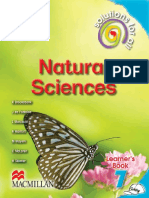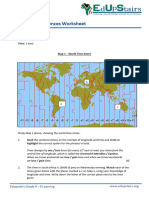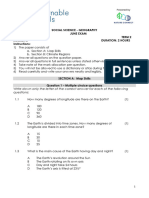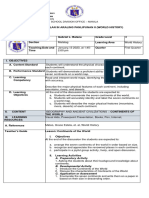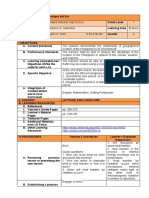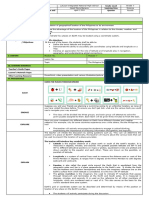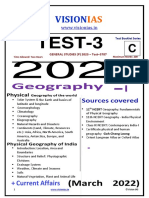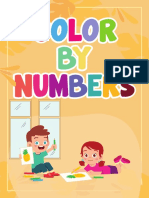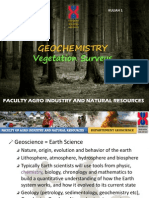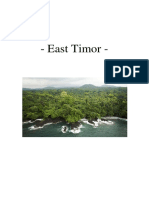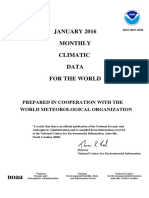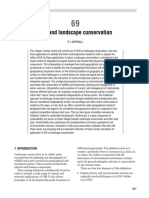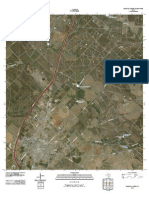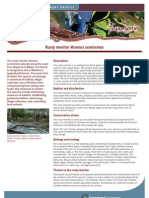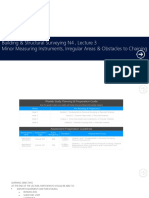Professional Documents
Culture Documents
Gr6 Social Sciences Extension and Remediation Worksheet Book
Gr6 Social Sciences Extension and Remediation Worksheet Book
Uploaded by
ShayneOriginal Description:
Copyright
Available Formats
Share this document
Did you find this document useful?
Is this content inappropriate?
Report this DocumentCopyright:
Available Formats
Gr6 Social Sciences Extension and Remediation Worksheet Book
Gr6 Social Sciences Extension and Remediation Worksheet Book
Uploaded by
ShayneCopyright:
Available Formats
CAPS
Simply superior!
• Superior CAPS coverage and written by
expert authors
• Superior illustrations activities to improve results
and motivate learners
• Superior teacher support to save time and make
teaching easy, including photocopiable worksheets
• Superior quality = exam success!
Social Sciences
Grade 6
Extension and Remediation
Worksheet Book
www.mml.co.za
I S B N 978-0-636-14309-8
9 780636 143098
9780636143098C.indd 1-2 2012/06/19 11:33 AM
Geography Topic 1: Target Worksheet A
1. Match the words in the first column with their meanings in the
second column.
Equator Go around the Earth and run parallel to the equator
Greenwich Meridian Half of the Earth
Lines of longitude Divides the Earth into north and south
Lines of latitude Divides the Earth into east and west
Hemisphere Go around the earth from the North Pole to the South Pole
(5)
2. What countries would you find at the co-ordinates given below?
a. 10°S 50°W
b. 20°N 50°E (4)
3. Give the co-ordinates for the countries listed below (choose a point
that is more or less in the middle of the country).
a. India
b. Mexico (4)
4. Use the maps below to complete the questions.
a. For each of the maps, write down the word scale. (4)
b. How many kilometres on the ground is 4 cm distance on the
map of South Africa? (2)
c. What is the distance on the ground between two places that are
4 cm apart on the street map of Durban? (2)
Social Sciences Grade 6 © Maskew Miller Longman (Pty) Ltd. Permission is granted to photocopy this page.
mml_9780636143098_Plat_SS_g06_tws_eng_zaf.indd 1 2012/07/27 4:51 PM
5. Refer to the map below. Calculate the straight-line distance on the
ground from:
a. Cape Town to Kimberley (3)
b. Durban to Musina (3)
6. Refer to the contents page below and answer the questions.
a. How many maps of the world are given in this atlas? (2)
b. On which page can you find information about the province you
live in? (2)
Contents
Map Skills KwaZulu-Natal 22 Europe 39
Map symbols 4–5 Mpumalanga 23 Australia and
Direction 6 Limpopo 24 New Zealand 40
Lines of latitude and North-West 25 North America 41
longitude 7 Free State 26 South America 42
Scale 8–9 Gauteng 27
Pacific Ocean and
South Africa World Islands 43
Physical 10–11 Physical 28–29 Antarctica 44
Political 12–13 Political 30–31
Climate 14 Climate and
Earth in Space
Vegetation 14 vegetation
32–33 The solar system 45
Agriculture 15 Population
34–35 Seasons and time zones 46
Mining and minerals 15 The moon 47
The continents and the
South Africa’s Provinces Pacific Ocean Index
Northern Cape 16–17 Africa – political 36 Index of place names 48–52
Western Cape 18–19 Africa – physical 37
Eastern Cape 20–21 Asia 38
Social Sciences Grade 6 © Maskew Miller Longman (Pty) Ltd. Permission is granted to photocopy this page.
mml_9780636143098_Plat_SS_g06_tws_eng_zaf.indd 2 2012/07/27 4:51 PM
7. Use the statistics in the table below to answer the following questions.
a. Name the second longest river.
b. Name the third largest country.
c. Name the largest city in the world.
d. Name the largest hot desert. (4)
8. How many more people live in New York than in Sao Paulo? (2)
Rivers Length Mountains Height (in m) Cities Population
(number of
people)
Nile 6 695 Mount 8 848 Tokyo 34 400 000
Amazon 6 516 Everest 8 611 New York 20 100 000
Yangtze 6 380 K-2 8 586 Sao Paulo 17 700 000
Kang-
chenjunga
Countries Size (in Hot deserts Size (in Oceans Size (in
square km) square km) square km)
Russia 17 098 442 Sahara 9 100 000 Pacific 155 557 000
Canada 9 984 670 Arabian 2 330 000 Atlantic 76 762 000
China 9 640 011 Desert
Kalahari 900 000 Indian 68 556 000
Forests Size (in
square km)
Russian 7 762 602
Taiga
Amazon 5 500 000
Canadian
Taiga 3 101 340
9. Write down three different ways that we can find out about current
events. (3)
(40 marks)
Social Sciences Grade 6 © Maskew Miller Longman (Pty) Ltd. Permission is granted to photocopy this page.
mml_9780636143098_Plat_SS_g06_tws_eng_zaf.indd 3 2012/07/27 4:51 PM
Geography Topic 1: Target Worksheet B
1. Answer these questions.
a. Name the 0° line of latitude. (1)
b. Which line divides the Earth into a western and eastern
hemisphere? (1)
c. How many degrees of longitude is the Earth divided into?
(Remember that the Earth is round.) (2)
d. Africa lies in three hemispheres. Name them. (3)
2. Give the co-ordinates for the countries listed below (choose a point
that is more or less in the middle of the country).
a. United Kingdom
b. Ecuador
c. New Zealand (6)
3. Which map of South Africa would be bigger: a map with a scale of
1 cm = 300 km, or a map with a scale of 1 cm = 100 km? (1)
4. Look at the map below and answer the questions.
a. How far is it from the Royal Yacht Club in Durban to Kings Park
Stadium on the ground? (3)
b. Draw your own line scale for this word scale: 1 cm on the map =
250 km on the ground. (2)
Social Sciences Grade 6 © Maskew Miller Longman (Pty) Ltd. Permission is granted to photocopy this page.
mml_9780636143098_Plat_SS_g06_tws_eng_zaf.indd 4 2012/07/27 4:51 PM
5. Look at the map below and answer the questions.
a. How much further is it on the ground from Cape Town to East
London than it is from Cape Town to George? (6)
b. How far is it from Cape Town to Musina if you travel through
Upington on the way? (4)
Contents
Map Skills KwaZulu-Natal 22 Europe 39
Map symbols 4–5 Mpumalanga 23 Australia and
Direction 6 Limpopo 24 New Zealand 40
Lines of latitude and North-West 25 North America 41
longitude 7 Free State 26 South America 42
Scale 8–9 Gauteng 27
Pacific Ocean and
South Africa World Islands 43
Physical 10–11 Physical 28–29 Antarctica 44
Political 12–13 Political 30–31
Climate 14 Climate and
Earth in Space
Vegetation 14 vegetation
32–33 The solar system 45
Agriculture 15 Population
34–35 Seasons and time zones 46
Mining and minerals 15 The moon 47
The continents and the
South Africa’s Provinces Pacific Ocean Index
Northern Cape 16–17 Africa – political 36 Index of place names 48–52
Western Cape 18–19 Africa – physical 37
Eastern Cape 20–21 Asia 38
Social Sciences Grade 6 © Maskew Miller Longman (Pty) Ltd. Permission is granted to photocopy this page.
mml_9780636143098_Plat_SS_g06_tws_eng_zaf.indd 5 2012/07/27 4:51 PM
6. Refer to the contents page on the previous page and say on which
page in the atlas you would find each of the following:
a. crops grown in South Africa (1)
b. parts of the world that have the most people living in them (1)
c. names of the planets (1)
7. Use the table below to answer the questions.
Rivers Length Mountains Height (in m) Cities Population
(number of
people)
Nile 6 695 Mount 8 848 Tokyo 34 400 000
Amazon 6 516 Everest 8 611 New York 20 100 000
Yangtze 6 380 K-2 8 586 Sao Paulo 17 700 000
Kang-
chenjunga
Countries Size (in Hot deserts Size (in Oceans Size (in
square km) square km) square km)
Russia 17 098 442 Sahara 9 100 000 Pacific 155 557 000
Canada 9 984 670 Arabian 2 330 000 Atlantic 76 762 000
China 9 640 011 Desert
Kalahari 900 000 Indian 68 556 000
Forests Size (in
square km)
Russian 7 762 602
Taiga
Amazon 5 500 000
Canadian
Taiga 3 101 340
a. How much longer is the Nile River than the Amazon River? (2)
b. What is the size of the three largest hot deserts added together? (2)
c. How much bigger is the Atlantic Ocean than the Indian Ocean? (2)
8. Write down two important current events that you have heard
about this week. (2)
(40 marks)
Social Sciences Grade 6 © Maskew Miller Longman (Pty) Ltd. Permission is granted to photocopy this page.
mml_9780636143098_Plat_SS_g06_tws_eng_zaf.indd 6 2012/07/27 4:52 PM
Geography Topic 2: Target Worksheet A
1. Match the word in the first column with its meaning in the
second column. (5)
barter the exchange of goods
value the goods a country buys from another country
trade the goods a country sells to another country
imports to exchange of goods without using money
exports the amount of money something is worth
2. Name four of South Africa’s main exports. (4)
3. List three electrical goods that South Africa imports. (3)
4. From which country does South Africa import electrical goods? (1)
5. Name three countries that South Africa trades with. (3)
6. With which country does South Africa trade the most? (1)
7. Put each of the following products into the correct column: coal,
maize, television sets, tinned fruit, oranges, jewellery and bread. (6)
Primary products (raw materials) Secondary products (manufactured goods)
8. Match the words in the first column with what they mean in the
second column. (4)
skills things people do for others
services things that have been made in factories
factories things that people do
secondary products buildings where things are made using tools and machines
9. Place these sentences in the correct order.
The beans are dried.
The chocolate is wrapped and sold.
The beans are processed in factories to make chocolate.
The cocoa beans are picked from trees. (4)
10. Explain why an ounce of gold jewellery is worth more than an
ounce of pure gold. Use these words in your answer: skills,
machines and manufacturing process. (3)
11. Explain how fair trade in Ghana helped the children to go to school
and made clean water available. (4)
12. Give two problems that are the result of unfair trade. (2)
(40 marks)
Social Sciences Grade 6 © Maskew Miller Longman (Pty) Ltd. Permission is granted to photocopy this page.
mml_9780636143098_Plat_SS_g06_tws_eng_zaf.indd 7 2012/07/27 4:52 PM
Geography Topic 2: Target Worksheet B
1. Most of South Africa’s imports are manufactured goods.
a. What are manufactured goods? (2)
b. Give two examples of manufactured goods that South Africa imports. (2)
2. Look at the table below and then answer the questions.
Ranking Country Value of imports to South Africa
1 China R84 billion
2 Germany R67 billion
3 USA R42 billion
4 Japan R31 billion
5 Saudi Arabia R24 billion
a. What is the total value of imports from these countries to
South Africa? (3)
b. How much more does South Africa import from Germany than
from Japan? (2)
c. What is the main import from Saudi Arabia? (1)
d. On which continent do we find China and Japan? (1)
3. Complete the table by filling in the raw material each manufactured
item is made from. (4)
Manufactured items Raw materials
book
door frame
chair
basket
4. What services do these people provide? (4)
Social worker Travel agent
Doctor Shopkeeper
5. Select one of these items: engagement ring, bicycle, ice-cream. For
your choice of item write about: the raw materials needed, the
manufacturing processes, the cost of the item and where it is sold. (8)
6. Draw a simple flowchart to show the processes involved in making
gold jewellery from the mining for gold to selling gold jewellery. (8)
7. When trade is fair people are able to earn enough money and
improve their lives. Write a paragraph to explain what happens
when trade is fair. (5)
(40 marks)
Social Sciences Grade 6 © Maskew Miller Longman (Pty) Ltd. Permission is granted to photocopy this page.
mml_9780636143098_Plat_SS_g06_tws_eng_zaf.indd 8 2012/07/27 4:52 PM
Geography Topic 3: Target Worksheet A
1. Fill in the missing words about climates of the world.
In hot climates, temperatures are usually above ________. In
________ climates temperatures are usually between 10 °C and
30 °C. In cold climates temperatures are usually below ________.
Wet areas usually get more than ________ of rain a year, while dry
areas get less than ________ of rain.
During January the ________ hemisphere has summer and the
________ hemisphere has winter. (7)
2. Describe the climate of the following countries. You must say what
it is like in summer and in winter, and how much rain it gets.
a. South Africa
b. Canada (6)
3. Look at the diagram below. Identify the types of vegetation labelled
A to D. Choose from the following words: forest floor, canopy,
understorey, emergent. (4)
Social Sciences Grade 6 © Maskew Miller Longman (Pty) Ltd. Permission is granted to photocopy this page.
mml_9780636143098_Plat_SS_g06_tws_eng_zaf.indd 9 2012/07/27 4:52 PM
4. Draw a simple mind map to show the effects of deforestation. (5)
5. Fill in the following hot deserts on the world map: Sahara, Mojave,
Atacama, Kalahari. (4)
6. Explain how the plants and animals that live in hot deserts have
adapted to live in this climate. Give one example of a plant and one
of an animal that can survive in the desert. (6)
7. Where are the seeds of coniferous forests found? (2)
8. How is the spruce tree able to survive? (2)
9. How do people that live in coniferous forests affect the
environment? (4)
(40 marks)
Social Sciences Grade 6 © Maskew Miller Longman (Pty) Ltd. Permission is granted to photocopy this page.
mml_9780636143098_Plat_SS_g06_tws_eng_zaf.indd 10 2012/07/27 4:52 PM
Geography Topic 3: Target Worksheet B
1. Look at the map below and answer the questions.
a. What season is it in the southern hemisphere? How do you know? (2)
b. Name two countries in the southern hemisphere that can be
classified as hot. (2)
c. Name two countries in the northern hemisphere that can be
classified as cold. (2)
2. Name two countries in the southern hemisphere that receive more
than 3 000 mm of rain a year. (2)
3. Name two countries in the southern hemisphere that receive less
than 250 mm of rain a year. (2)
4. Complete the following table to show the differences between
tropical and coniferous forests. (20)
Tropical forests Coniferous forests
Climate in which they grow:
Where they are found (give two
countries as examples):
What the trees are like:
How the animals that live here
have adapted:
Social Sciences Grade 6 © Maskew Miller Longman (Pty) Ltd. Permission is granted to photocopy this page.
mml_9780636143098_Plat_SS_g06_tws_eng_zaf.indd 11 2012/07/27 4:52 PM
5. The graph below shows the rainfall and temperature for a hot desert.
Hot Desert
40 400
36 360
32 320
precipitation (mm)
temperature (˚C)
28 280
24 240
20 200
16 160
12 120
8 60
4 40
0 0
JAN FEB MAR APR MAY JUN JUL AUG SEP OCT NOV DEC
months
precipitation (des) temperature (des)
In which two months are the hottest temperatures recorded?
a. (2)
What is the total annual rainfall?
b. (2)
Is this desert in the northern or southern hemisphere?
c. (1)
Does the rain fall in summer or winter?
d. (1)
What is the lowest recorded temperature and in which month
e.
was it recorded? (2)
6. Name two ways that plants in the desert adapted for survival. (2)
(40 marks)
Social Sciences Grade 6 © Maskew Miller Longman (Pty) Ltd. Permission is granted to photocopy this page.
mml_9780636143098_Plat_SS_g06_tws_eng_zaf.indd 12 2012/07/27 4:52 PM
Geography Topic 4: Target Worksheet A
1. Look at the map below and then answer the questions.
a. Which province is the most thinly populated?
b. Which province is the most densely populated?
c. Which cities in the Eastern Cape have over a million people? (4)
2. Use the graph below to answer these questions.
a. Which province has the second largest population? What is its
population in millions? (2)
Social Sciences Grade 6 © Maskew Miller Longman (Pty) Ltd. Permission is granted to photocopy this page.
mml_9780636143098_Plat_SS_g06_tws_eng_zaf.indd 13 2012/07/27 4:52 PM
b. Which province has the second smallest population? What is its
population in millions? (2)
c. What is the total population of the Western Cape? (2)
3. Use these words to complete the information table about rural and
urban areas: densely populated, fewer people, many different jobs
for people, thinly populated, more people, many people are
farmers. (6)
Rural areas Urban areas
4. List five reasons why people live where they do. (5)
5. Write down four problems that people living in rural areas
may have. (4)
6. Write down four problems that people living in urban areas
may have. (4)
7. Name two cities in Asia that have more than 10 million people. (2)
8. Each of these sentences is false. Change the underlined words to
make them true.
a. Africa is the most densely populated continent.
b. Most people in Egypt live along the coast.
c. Pretoria in Gauteng has more than 10 million people.
d. Japan is sparsely populated.
e. Most people in Brazil live along the Amazon River. (5)
9. Write down four resources that attracted people to Rio de Janeiro. (4)
(40 marks)
Social Sciences Grade 6 © Maskew Miller Longman (Pty) Ltd. Permission is granted to photocopy this page.
mml_9780636143098_Plat_SS_g06_tws_eng_zaf.indd 14 2012/07/27 4:52 PM
Geography Topic 4: Target Worksheet B
1. Look at the map below and then answer the questions.
a. South Africa has an uneven population distribution. Write a
paragraph in which you describe the population distribution of
South Africa. Talk about the different provinces. (6)
b. Give possible reasons why Johannesburg and Durban have
grown to become large urban areas. (4)
2. Use the graph below to answer the questions.
a. What is the combined population of the two provinces with the
largest populations? Name the provinces. (4)
Social Sciences Grade 6 © Maskew Miller Longman (Pty) Ltd. Permission is granted to photocopy this page.
mml_9780636143098_Plat_SS_g06_tws_eng_zaf.indd 15 2012/07/27 4:52 PM
b. What is the combined population of the two provinces with the
smallest populations? Name the provinces. (4)
3. Compare rural and urban areas. In your comparison, talk about size
or area, jobs, and population. (6)
4. Why do so many people live in Cape Town? Write down six possible
reasons. Refer to history, climate, resources, job opportunities and
attractions in your answer. (6)
5. More people live in the northern hemisphere than the southern
hemisphere.
a. Why do you think this is so? (2)
b. Which two countries in Asia have the largest populations? (2)
c. Why do so few people live in the northern part of Canada? (1)
6. Complete each of these sentences by filling in the missing words.
a. ________ is the most densely populated continent.
b. ________ is the most sparsely populated continent.
c. Most people in Egypt have settled along the ________ because
________.
d. The Middle East is hot and dry, but many people live there.
They were attracted by the ________ resources. (5)
(40 marks)
Social Sciences Grade 6 © Maskew Miller Longman (Pty) Ltd. Permission is granted to photocopy this page.
mml_9780636143098_Plat_SS_g06_tws_eng_zaf.indd 16 2012/07/27 4:52 PM
History Topic 1: Target Worksheet A
1. Match the dates in Column A with the date of settlement at the
place in Column B.
Column A Column B
a. 1280 AD 1. Great Zimbabwe
b. 900 AD 2. Mapungubwe
c. 1220 AD 3. K2 and Schroda
(3)
2. How many years are there in a millennium? (1)
3. What started happening along the east coast of Africa from 700 AD? (1)
4. What did African farmers at K2 trade with other people? (1)
5. How do we know what was traded? (1)
6. Explain the term ‘Swahili’. (2)
7. What did the Swahili traders want to buy from African farmers? (3)
8. What did the Swahili traders give to the African farmers in return? (3)
9. Fill in the missing words.
Mapungubwe was a _____(a)_____ society that developed in the
_____(b)_____ River valley about _____(c)_____ years ago.
Mapungubwe’s trade network covered what is today _____(d)_____,
Zimbabwe and southern _____(e)_____. It also had links across the
_____(f)_____ Ocean to the Middle East and _____(g)_____ today. The
area is populated by _____(h)_____-speaking people and it is a World
_____(i)_____ Site. The _____(j)_____ of Mapungubwe is a special
award given to South African citizens for exceptional service. (10)
10. Why was gold so valuable in the time of Mapungubwe? (2)
11. Write a short paragraph on the Golden Rhinoceros of Mapungubwe. (3)
12. In what country was Marco Polo born? (1)
13. What was the name of the overland route to China? (1)
14. Who did Marco Polo work for in China? (1)
15. Why did Marco Polo’s friends and family not recognise him when
he returned home? (2)
16. Give two examples of the things he brought with him from China. (2)
17. List three Chinese inventions that Marco Polo reported on in his
book about his travels. (3)
(40 marks)
Social Sciences Grade 6 © Maskew Miller Longman (Pty) Ltd. Permission is granted to photocopy this page.
mml_9780636143098_Plat_SS_g06_tws_eng_zaf.indd 17 2012/07/27 4:52 PM
History Topic 1: Target Worksheet B
1. Put these events in the correct order.
Marco Polo stopped working for the Chinese emperor.
Farmers started settling at K2 and Schroda.
Marco Polo published his book The Travels of Marco Polo.
A settlement was created at Mapungubwe.
Marco Polo set off along the Silk Road. (5)
2. Explain the terms given below.
a. millennium b. hierarchy
c. archaeologist d. ritual
e Swahili (5)
3. State whether the following statements about Mapungubwe are
true or false. Where they are false, you must write the correct answer.
a. Historians can learn about Mapungbuwe by reading the books
written by people who lived there.
b. Mapungubwe was the first state in southern Africa.
c. Leaders and their families lived apart from the ordinary people.
d. The king always did the rain-making dance on his own.
e. The most famous symbol of Mapungubwe is the rhinoceros
carved out of ivory.
f. Mapungubwe is a busy city today. (10)
4. What is an artefact? Give an example. (2)
5. List four similarities that the settlement at Great Zimbabwe shared
with Mapungubwe. (4)
6. The people of Mapungubwe used the symbol of a rhinoceros and
the people of Zimbabwe used a crocodile. What were they meant to
symbolise and what qualities do you think these animals share that
led to them being chosen as symbols? (4)
7. Compare the early settlements at K2 and Schroda with the later
settlements at Mapungubwe and Great Zimbabwe. Your answer
should cover social structure and economic activity. (4)
8. Imagine that Marco Polo went on one more long journey after his
return to Italy in 1295, to Great Zimbabwe. Write a letter from Marco
Polo to his best friend (Luigi) in which you detail all the interesting
things you find. Note the differences and the similarities with what
you know and have experienced, in Italy and in China. (6)
(40 marks)
Social Sciences Grade 6 © Maskew Miller Longman (Pty) Ltd. Permission is granted to photocopy this page.
mml_9780636143098_Plat_SS_g06_tws_eng_zaf.indd 18 2012/07/27 4:52 PM
History Topic 2: Target Worksheet A
1. In what country did the Renaissance begin? (1)
2. Which country’s art and literature was re-discovered in the
Renaissance? (1)
3. Explain why the Renaissance is described as a ‘turning point’. (2)
4. In what century is the date 1501? (1)
5. Give two examples of inventions that Leonardo da Vinci worked on
that are now part of modern life. (2)
6. What did Galileo’s research prove about the solar system? (2)
7. What new invention helped Galileo find out about the solar system? (1)
8. Why were gunpowder and guns important for European explorers? (2)
9. What kind of needle is used in a compass? (1)
10. How did the invention of the compass change the way sailors
thought about sea journeys? (2)
11. Each of the words or phrases listed below is linked to a reason for
Europeans exploring the world. Write one sentence about each,
explaining that link.
a. Renaissance
b. high taxes
c. nutmeg, pepper, cinnamon
d. silk
e. Christianity (5 × 2 = 10)
12. Why was Portugal the first country to send out explorers? (2)
13. What is a padrão and why did Portuguese explorers put them up? (2)
14. Which country started competing with Portugal from about 1600? (1)
15. What was the reaction of Khoikhoi herders who first saw European
explorers on the beach at what is now Mossel Bay? (2)
16. Did Vasco da Gama find his way to India all on his own? Explain
your answer. (4)
17. Why were the Swahili traders on Africa’s east coast not interested
in trading with the Portuguese? (4)
(40 marks)
Social Sciences Grade 6 © Maskew Miller Longman (Pty) Ltd. Permission is granted to photocopy this page.
mml_9780636143098_Plat_SS_g06_tws_eng_zaf.indd 19 2012/07/27 4:52 PM
History Topic 2: Target Worksheet B
1. Do you agree or disagree with the following statements? You must
give reasons for your answer.
a. The voyages of discovery by Europeans in the 15th and 16th
centuries would not have happened without the Renaissance. (3)
b. Europeans took the lead in travelling around the world because
they had good technology. (3)
c. Europeans and Africans were very glad to meet one another
when they first made contact in southern and eastern Africa. (3)
d. Although the journeys of discovery were very long and
dangerous, they were worth the danger for the benefits they
brought to society. (3)
2. Is Leonardo da Vinci the reason that Afrikaans is one of South
Africa’s official languages today? Show how Afrikaans came to be
an official language today by explaining the connection between
each of the boxes shown below. (5 × 2 = 10)
a. Leonardo da Vinci b. compass c. nutmeg
e. Afrikaans is one of South Africa’s d. An Arab ship’s pilot
eleven official languages agrees to help
3. Explain how each of these facts or statements supports the idea
that explorers were looking for trade and profit.
a. High taxes were charged on the land route to the East.
b. Bartholomew Dias named the area he passed as the Cape of
Good Hope.
c. Da Gama was treated as a hero when he returned from his journey.
d. The Dutch East India Company was formed.
e. The Dutch ships attacked Portuguese ships. (5 × 2 = 10)
4. At what point on the African coast (name of the modern town) did
Bartholomew Dias decide to turn back for Portugal? (1)
5. Where did Vasco da Gama’s trip stop on the east African coast in
April 1498? (1)
6. At which Indian city did da Gama end his first trip? (1)
Social Sciences Grade 6 © Maskew Miller Longman (Pty) Ltd. Permission is granted to photocopy this page.
mml_9780636143098_Plat_SS_g06_tws_eng_zaf.indd 20 2012/07/27 4:52 PM
7. Imagine that you are an ivory trader from the Great Zimbabwe
settlement, which you studied in Grade 5. You have gone down to the
coast to sell your ivory to Arab traders. Your visit coincides with the
arrival of Vasco da Gama and his party. The Portuguese come ashore
and, through a translator, you are able to ask them about their
journey and where they come from. Now write a speech in which
you report back to your village and chief on what you saw and learnt
about these strangers. (5)
(40 marks)
Social Sciences Grade 6 © Maskew Miller Longman (Pty) Ltd. Permission is granted to photocopy this page.
mml_9780636143098_Plat_SS_g06_tws_eng_zaf.indd 21 2012/07/27 4:52 PM
History Topic 3: Target Worksheet A
1. Choose the sentence which best describes the following words:
a. democracy
i. a system where the king rules
ii. a system where all people can choose their leaders
iii. a system where the king is chosen by all the people
b. constitution
i. the laws of a country
ii. the courts of a country
iii. the court system of a country
c. vote
i. people choose who they want to run the country
ii. people are put in positions of power to run the country
iii. people discuss how they want to run the country
d. political party
i. a group of people who write laws
ii. a group of people who hold parties
iii. a group of people who agree on how the country should be run
e. government
i. the richest people in the country
ii. the leaders of a country
iii. people who decide who should go to jail
f. citizen
i. person who visits a country
ii. person who belongs to a country and has rights there
iii. person who runs a country (6)
2. Write down any four of the rights that every South African has,
according to the Constitution. (4)
3. Fill in the missing blocks in the table:
Branch of government Who/what makes up Function of the branch
this branch
Legislature Parliament a.
b. President and cabinet c.
Judiciary d. e.
(5 × 2 = 10)
Social Sciences Grade 6 © Maskew Miller Longman (Pty) Ltd. Permission is granted to photocopy this page.
mml_9780636143098_Plat_SS_g06_tws_eng_zaf.indd 22 2012/07/27 4:52 PM
4. Match a responsibility to a right.
Right Responsibility
Right to vote in elections a.
Right to free speech, to say b.
when I disagree with something
Right to education c.
(3)
5. What did Fatima Meer do to fight for the rights of South Africans
who did not have rights? (2)
6. In what year was the International Summit on the Rights of
Children held in South Africa?
7. What was the name of the list of rights that was written down after
this meeting?
8. At what age do you stop being called a child?
9. Explain these terms:
a. child labour
b. discrimination (5)
10. Who wrote ‘Nkosi sikelel’ iAfrika’?
11. In what year was it written?
12. Where was it first sung?
13. How many languages are in the South African national anthem?
14. What is South Africa’s motto? (5 × 2 = 10)
(40 marks)
Social Sciences Grade 6 © Maskew Miller Longman (Pty) Ltd. Permission is granted to photocopy this page.
mml_9780636143098_Plat_SS_g06_tws_eng_zaf.indd 23 2012/07/27 4:52 PM
History Topic 3: Target Worksheet B
1. When did South Africa hold its first democratic elections? (1)
2. Why were elections held before that date not democratic? (1)
3. Name the two houses that make up parliament. (2)
4. Name three South African political parties. (3)
5. Explain why a democratic system is called ‘government by the
people and government for the people’. (3)
6. People like Fatima Meer and Pius Langa made great sacrifices to
achieve democracy. In your opinion, is democracy worth fighting
for? Give reasons for your answer. (5)
7. Who must obey the laws written in a country’s constitution? (1)
8. When is it acceptable to change a constitution? (2)
9. a. What are the names of the three branches of government? (3)
b. What does each branch do? (3)
c. Which is the most important branch, in your opinion? (3)
10. Give two examples of human rights that are for adults and children. (2)
11. Give two examples of human rights that are only for children. (2)
12. If you were President of South Africa, which one of the children’s
rights would be most important for you? What law or laws would
you pass to make sure that right was carried out to help the
country’s children? (2)
13. What is South Africa’s motto? (1)
14. What language is written on the Coat of Arms? (1)
15. Choose any five parts of the Coat of Arms and state what each
one represents. (5)
(40 marks)
Social Sciences Grade 6 © Maskew Miller Longman (Pty) Ltd. Permission is granted to photocopy this page.
mml_9780636143098_Plat_SS_g06_tws_eng_zaf.indd 24 2012/07/27 4:52 PM
History Topic 4: Target Worksheet A
1. Fill in the correct missing words.
Indigenous medicines that South Africans use come from _____(a)_____.
The two main kinds of traditional healers are _____(b)_____ and
_____(c)_____. A plant called _____(d)_____ is used to treat stomach
and bladder problems. Sangomas are called by their _____(e)_____
to help people. After three months training, young sangomas may
put _____(f)_____ clay on their bodies. (6)
2. Match the words in Column A with the correct words in Column B.
Column A Column B
1. germs that cause infections a. Louis Pasteur
2. identified the germ that causes TB b. tuberculosis
3. is spread by coughing and sneezing c. harmful bacteria
4. linked germs and disease d. smallpox
5. causes high temperatures and sores e. Dr Koch
all over the body
(5)
3. Explain the link between these words: mould, animals, penicillin
and antibiotics. (4)
4. Who was the first doctor to perform a heart transplant? (1)
5. In what year was the heart transplant performed? (1)
6. In which hospital was the first heart transplant performed? (1)
7. What was the name of the first person to receive a new heart? (1)
8. How long did he live after the operation? (1)
(20 marks)
Social Sciences Grade 6 © Maskew Miller Longman (Pty) Ltd. Permission is granted to photocopy this page.
mml_9780636143098_Plat_SS_g06_tws_eng_zaf.indd 25 2012/07/27 4:52 PM
History Topic 4: Target Worksheet B
1. Link the date in the first column with an event in the second column.
Date Event
1. Early 20th century a. First heart transplant
2. 1882 b. Western medicine rediscovers holistic healing
3. 1796 c. Alexander Fleming injected mould into animals
4. 1967 d. Edward Jenner discovered a vaccine for smallpox
5. 1928 e. Dr Robert Koch discovered the germ that causes TB
(5)
2. Which one of the medical events or discoveries listed above has
had the biggest influence on modern living? (5)
3. Give the meaning of each term given below.
a. diagnose
b. prescribe
c. immunise
d. anaesthetise
e. counsel (5)
4. Write two sentences on how each of the following types of healers
heal their patients:
a. diviners/sangomas
b. herbalists (2 × 3 = 6)
5. Would it be an advantage or a disadvantage if a Western-trained
doctor also had some of the skills of a diviner or herbalist? (4)
6. Explain how people are chosen to become sangomas and what
their training involves. (5)
7. State whether you agree or disagree with the following statements.
Give reasons for your answer.
a. Edward Jenner was the bravest man in the history of medicine. (5)
b. South Africa should not spend money on heart transplants when
thousands of people have tuberculosis. (5)
(40 marks)
Social Sciences Grade 6 © Maskew Miller Longman (Pty) Ltd. Permission is granted to photocopy this page.
mml_9780636143098_Plat_SS_g06_tws_eng_zaf.indd 26 2012/07/27 4:52 PM
Target Worksheet Answers
Geography Topic 1: Target Worksheet A
1. (5)
Equator Divides the Earth into north and south
Greenwich Meridian Divides the Earth into east and west
Lines of longitude Go around the earth from the North Pole to the South Pole
Lines of latitude Go around the Earth and run parallel to the equator
Hemisphere Half of the Earth
2. a. Brazil
b. Saudi Arabia (4)
3. a. 20 °N 77 °E
b. 23 °N 102 °W (4)
4. a. South Africa: 1 cm on the map is = 200 km on the ground
Durban: 1 cm on the map is = 1 km on the ground (4)
b. 800 km (2)
c. 4 km (2)
5. a. Cape Town to Kimberley: 3,8 cm × 155 km = 589 km (3)
b. Durban to Musina: 3,7 cm × 155 km = 573,5 km (3)
6 a. 4 (2)
b. Learners’ answers will vary but will lie between pages 16 and 27. (2)
7. a. The Amazon
b. China
c. Tokyo
d. Sahara (4)
8. 20 100 000 –17 700 000 = 2 400 000 (2)
9. Accept any three valid answers, e.g. radio, television, newspapers, the Internet. (3)
(40 marks)
Geography Topic 1: Target Worksheet B
1. a. The equator (1)
b. Greenwich Meridian (1)
c. 360° (2)
d. northern, southern, eastern (3)
2. a. United Kingdom – 50° N 0°
b. Ecuador – 0° 80° W
c. New Zealand – 40° S 180° W (6)
3. a map with a scale of 1 cm = 100 km (1)
4. a. Distance from the Royal Yacht Club in Durban to Kings Park Stadium:
4 cm × 1 km = 4 km (3)
b. 0 250 500 750 1 000 1 250 1 500 1 750 2 000 2 250 2 500 km (2)
1 cm on the map = 250 km on the ground
5. a. Cape Town to East London: 4,5 cm × 155 km = 697,5 km
Cape Town to George: 1,8 cm × 155 km = 279 km
Difference: 418,5 km (6)
Social Sciences Grade 6 © Maskew Miller Longman (Pty) Ltd. Permission is granted to photocopy this page.
mml_9780636143098_Plat_SS_g06_tws_eng_zaf.indd 27 2012/07/27 4:52 PM
b. Cape Town to Upington: 3 cm × 155 km = 465 km
Upington to Musina: 5,1 cm × 155 km = 790,5 km
Total: 1 255,5 km (4)
6. a. page 15 (1)
b. pages 34–35 (1)
c. page 45 (1)
7. a. 6 695 km– 6 516 km = 179 (2)
b. 9 100 000 + 2 330 000 + 900 000 = 12 330 000 (2)
c. 76 762 000 sq. km – 68 556 000 sq. km = 8 206 000 sq. km (2)
8. Accept any valid current events. (2)
(40 marks)
Geography Topic 2: Target Worksheet A
1. (5)
barter to exchange goods without using money
value the amount of money something is worth
trade the exchange of goods
imports the goods a country buys from another country
exports the goods a country sells to another country
2. Accept any four of the following: gold, iron, fruit, tourism, car parts (4)
3. Accept any three valid answers: e.g. television sets, washing machines, ovens,
DVD players, computers (3)
4. Japan (1)
5. Accept any three of the following: China, Europe, USA, Japan, Saudi Arabia (3)
6. China (1)
7. (6)
Primary products (raw materials) Secondary products (manufactured goods)
coal television sets
maize tinned fruit
oranges jewellery
8. (4)
skills things that people do
services things people do for others
factories buildings where things are made using tools and machines
secondary products things that have been made in factories
9. The cocoa beans are picked from trees.
The beans are dried.
The beans are processed in factories to make chocolate.
The chocolate is wrapped and sold. (4)
10. Jewellery has been through a number of manufacturing processes. This needs skilled
workers who can use the machinery. (3)
11. The workers on the cocoa farm sold their beans to a company in Belgium. The buyers
and sellers agreed on a fair price. The company in Belgium gave the workers money to
build a school and a dam. (4)
12. Accept any two of the following: Low wages. Children are forced to work. People can’t
afford education and health care. People do not develop skills. The government can’t
afford to train people. (2)
(40 marks)
Social Sciences Grade 6 © Maskew Miller Longman (Pty) Ltd. Permission is granted to photocopy this page.
mml_9780636143098_Plat_SS_g06_tws_eng_zaf.indd 28 2012/07/27 4:52 PM
Geography Topic 2: Target Worksheet B
1. a. Goods that are made in factories from raw materials. (2)
b. Accept any valid examples, e.g. televisions, computers, cars. (2)
2. a. R248 billion (3)
b. R67 billion – R31 billion = R36 billion (2)
c. oil (1)
d. Asia (1)
3. Accept any valid answer, for example: (4)
Manufactured items Raw materials
book wood
door frame iron/wood
chair wood/iron
basket grass
4. Accept valid descriptions of each service. (4)
Social worker Helps people with their problems
Doctor Looks after the health of people who are sick
Travel agent Books holidays and transport for people
Shopkeeper Sells items to people
5. Learners’ answers will vary but must include all requested aspects. (8)
6.
separating
crushing the
mining for gold crushed smelting
rock
material
selling the manufacturing transporting pouring the
jewellery the jewellery the bars gold bars
(8)
7. When trade is fair, traders pay a fair price for crops and workers are paid fair wages.
No children are allowed to work and money goes to education and health care. Working
conditions are safe and healthy and workers can form companies and have more control
over prices and wages. (5)
(40 marks)
Geography Topic 3: Target Worksheet A
1. In hot climates, temperatures are usually above 25 °C. In mild climates temperatures are
usually between 10 °C and 30 °C. In cold climates temperatures are usually below 10 °C.
Wet areas usually get more than 1 000 mm of rain a year, while dry areas get less than
250 mm of rain.
During January the southern hemisphere has summer and the northern hemisphere has winter. (7)
2. a. South Africa – mostly under 250 mm of rain; winter: 0 to 20 °C; summer: 20 to 30 °C
b. Canada – between 250 and 1 000 mm of rain; winter: below 0 °C; summer between
0 and 20 °C (6)
3. A – emergent, B – canopy, C – understorey, D – forest floor (4)
Social Sciences Grade 6 © Maskew Miller Longman (Pty) Ltd. Permission is granted to photocopy this page.
mml_9780636143098_Plat_SS_g06_tws_eng_zaf.indd 29 2012/07/27 4:52 PM
4. (5)
no trees to loss of homes
cool the air for animals
no roots to
store water in Deforestation loss of plants
the soil
loss of homes
flooding
for people
5. Learners add the Sahara, Mojave, Atacama and Kalahari Deserts to the map. (4)
6. Some plants have long roots and some plants store water in their stems or leaves. Some
plants have poison or spikes for protection from animals, such as the barrel cactus and
Sturt’s desert pea. Some animals dig holes to escape from the sun. Some animals have
long claws to dig for insects, and some can go without water for a long time, for example
the meerkat and camel. (6)
7. The seeds are found in their cones. (2)
8. Its branches slope downwards so that the snow slides off and does not break the branches. (2)
9. They hunt and trap animals and cut down trees. This destroys the plant and animal life
of these areas. (4)
(40 marks)
Geography Topic 3: Target Worksheet B
1. a. Summer. The temperatures in the southern hemisphere are generally higher than in
the northern hemisphere. (2)
b. Botswana, Australia (2)
c. Accept any two of the following answers: Canada, Russia, Norway, Sweden,
Denmark. (2)
2. Brazil/ The DRC/ Madagascar (2)
3. Australia, Namibia, Chile (2)
4. (20)
Tropical forests Coniferous forests
Climate in which they grow: Hot areas with a lot of rain They are found in areas where
(6) around the equator. It is often the summers are short and
humid. the winters are long and cold
with heavy snowfall.
Where they are found (give Around the equator – Brazil, Canada, Scandinavia, Siberia
two countries as examples): (4) Congo, DRC
What the trees are like: (6) The trees grow tall and dense. The trees are mainly tall,
There are emergents, a narrow and coniferous. They
canopy, and an understorey. bear cones instead of flowers.
How the animals that live Many animals live in the trees Animals hibernate, migrate or
here have adapted: (4) and move from one tree to store food for winter. Some
another without ever touching have long, warm coats.
the ground.
Social Sciences Grade 6 © Maskew Miller Longman (Pty) Ltd. Permission is granted to photocopy this page.
mml_9780636143098_Plat_SS_g06_tws_eng_zaf.indd 30 2012/07/27 4:52 PM
5. a. May and June (2)
b. ±18 mm per year (2)
c. northern hemisphere (1)
d. summer (1)
e. 22 °C in December (2)
6. Accept any two of the following: Some have long roots. Some have spikes or poison.
Some store water in their stems and leaves. (2)
(40 marks)
Geography Topic 4: Target Worksheet A
1. a. Northern Cape
b. Gauteng
c. East London, Port Elizabeth (4)
2. a. KwaZulu-Natal – 10,6 million (2)
b. Free State – 1,9 million (2)
c. 5,2 million (2)
3. (6)
Rural areas Urban area
thinly populated densely populated
fewer people more people
many people are farmers many different jobs for people
4. Accept any five of the following: climate, vegetation, natural features, resources, jobs,
laws, history. (5)
5. Accept any four of the following: poverty, droughts, floods, unemployment, no
electricity, no clean water, lack of health services and lack of schools. (4)
6. Accept any four of the following: unemployment, crime, lack of housing, poverty,
overcrowding and pollution. (4)
7. Accept any two of the following: Tokyo, Jakarta, Shanghai, Delhi, Mumbai, Manila,
Osaka, Beijing, Kolkata and Bangkok. (2)
8. a. Asia is the most densely populated continent.
b. Most people in Egypt live along the Nile River.
c. Johannesburg in Gauteng has more than 10 million people.
d. Japan is densely populated.
e. Most people in Brazil live along the coast. (5)
9. Accept any four of the following: wood from forests, sugar, pleasant climate, gold and
diamonds, tourism. (4)
(40 marks)
Geography Topic 4: Target Worksheet B
1. a. Accept any six valid facts.
South Africa has an uneven population distribution. Most of the population is
concentrated in the smallest province of Gauteng.
The largest province, the Northern Cape, has the lowest population and population density.
It is a very dry province. The northern parts of the Western Cape are sparsely
inhabited, with people concentrated in the major towns and cities in the south. This
is because of the mountains and semi desert areas in the northern parts.
People are concentrated in the major cities of the provinces. (6)
b. Accept any valid reasons, for example:
Johannesburg – gold mining, many industries, good transport networks, pleasant
climate, employment opportunities
Durban – harbour, pleasant climate, industries, crops, employment opportunities (4)
Social Sciences Grade 6 © Maskew Miller Longman (Pty) Ltd. Permission is granted to photocopy this page.
mml_9780636143098_Plat_SS_g06_tws_eng_zaf.indd 31 2012/07/27 4:52 PM
2. a. Gauteng and KwaZulu-Natal. 11,3 million + 10,6 million = 21,9 million (4)
b. Northern Cape and Free State: 1,1 million + 2,8 million = 3,9 million (4)
3.
Rural areas Urban area
thinly populated densely populated
fewer people more people
many people are farmers many different jobs for people
(6)
4. Accept any six valid reasons, for example: Cape Town was the first place in South Africa
to be settled. It was on the old trade routes. It has a pleasant climate and a good
harbour. Crops like wheat and fruit grow well there. There is adequate water. There are
many businesses to provide jobs. There are many attractions like Table Mountain, the
sea and the Waterfront. (6)
5. a. Accept any valid reasons: climate, historical factors, more land in northern
hemisphere, countries and continents are close to each other. (2)
b. China and India (2)
c. It is very cold. /Temperatures are below freezing for much of the year. /It is covered
by snow and ice. (1)
6. a. Asia is the most densely populated continent.
b. Australasia is the most sparsely populated continent.
c. Most people in Egypt have settled along the Nile River because the rest of the
country is too dry.
d. The Middle East is hot and dry, but many people live there. They were attracted by
the oil resources. (5)
(40 marks)
History Topic 1: Target Worksheet A
1. a. 1280: 1. Great Zimbabwe
b. 900: 3. K2 and Schroda
c. 1220: 2. Mapungubwe (3)
2. one thousand (1)
3. Arab Muslims started settling in the area. (1)
4. ivory (elephant tusks) (1)
5. artefacts/archaeology (1)
6. Swahili means people of the coast. It is a mixture of cultures that developed along the
African east coast. (2)
7. ivory, gold, tortoise shells, rhino horn (Accept any three.) (3)
8. glass beads, cloth, carpets, glassware (3)
9. a. complex
b. Limpopo
c. 800
d. Botswana
e. Mozambique
f. Indian
g. India
h. Tshivenda
i. Heritage
j. Order (10)
10. It came from far. It was scarce. It does not rust. It lasts forever. (2)
11. It was made on wooden base. It has thinly beaten gold leaf pinned on it. It is an example
of great craftsmanship. It shows sophisticated skills. It was a symbol of leadership. The
rhinoceros is fierce and strong. The golden rhinoceros is associated with the king.
(Accept any three.) (3)
Social Sciences Grade 6 © Maskew Miller Longman (Pty) Ltd. Permission is granted to photocopy this page.
mml_9780636143098_Plat_SS_g06_tws_eng_zaf.indd 32 2012/07/27 4:52 PM
12. Italy (1)
13. Silk Road (1)
14. The emperor (Kublai Khan) (1)
15. They spoke in the Chinese language. They wore rough coats. They were dirty. (2)
16. jewels, ivory, coal, porcelain, silk, spices (Accept any two.) (2)
17. paper money, compass, gunpowder, printing (Accept any three.) (3)
(40 marks)
History Topic 1: Target Worksheet B
1. The correct order of the dates is given below.
Farmers started settling at K2 and Schroda.
A settlement was created at Mapungubwe.
Marco Polo set off along the Silk Road.
Marco Polo stopped working for the Chinese emperor.
Marco Polo published his book The Travels of Marco Polo. (5)
2. a. millennium: one thousand years
b. hierarchy: system where some are more powerful than others, there is a top and a bottom
c. archaeologist: scientist who studies artefacts (objects from the past)
d. ritual: a sacred or religious ceremony that is always done the same way
e. Swahili: people of the coast, mixed culture that developed along the African
east coast (5)
3. a. False. Historians can learn about Mapungbuwe by studying artefacts and archeology. (2)
b. True (1)
c. True (1)
d. False. The king called in rain-making specialists. (2)
e. False. The most famous symbol of Mapungubwe is the rhinoceros carved out of gold. (2)
f. False. Mapungubwe is deserted today. It is a national park. (2)
4. An artefact is an object from the past that we study to find out about the past. Examples
include a pot, a weapon and a tool. (2)
5. Four similarities:
• complex society
• hierarchy of social classes
• built on a hill
• king lived apart, on the hill
• small huts close together at the bottom of the hill
• traded with east coast traders (ivory, glass, cloth, etc.)
• symbols of power were made (rhino, bird)
(Accept any four.) (4)
6. Both symbolised power, associated with the king. Qualities shared: physically strong;
take-no-nonsense kind of animals; people would be scared of them; they are very aware
of what is going on around them; they live to great ages; people believed they were a
link to ancestors. Learners may have other valid perspectives. (4)
7.
K2, Schroda Later settlements
Social Small villages, not complex, Hierarchical with a king, classes separate,
structure self-sufficient. Social complex society, larger groups.
hierarchy based on gender.
Economic Farming crops and livestock Farming but also extensive trade, with coast
activity mostly. The beginnings of and beyond. Traded ivory, gold, rhino horn
trade based on ivory. and tortoise shells. Gold working skills
shows they could make sophisticated tools,
weapons and ornaments.
(Accept any four.) (4)
Social Sciences Grade 6 © Maskew Miller Longman (Pty) Ltd. Permission is granted to photocopy this page.
mml_9780636143098_Plat_SS_g06_tws_eng_zaf.indd 33 2012/07/27 4:52 PM
8. Date on letter, 1295
Dear Luigi
The letter will show the learner’s historical imagination and this should be the focus.
Some important points that should be noted include:
• dwellings made of stone
• skill in gold (fine objects)
• trade goes on between settlement and coast, making links with the East
• what is traded (Marco Polo would be very interested in this as he brought back
trading goods from East)
• hierarchy of society
• role of king
• role of ritual
• how people dress
• animals that are hunted (will be strange to Marco Polo although he may have seen
Asian rhinoceros and elephants on his travels)
• language spoken
(Award 4 marks for valid facts and 2 marks for creativity.) (6)
(40 marks)
History Topic 2: Target Worksheet A
1. Italy (1)
2. Greece (1)
3. It is described as a ‘turning point’ because of the changes in society/questioning sparked
further, greater change. (2)
4. 16th century (1)
5. bicycle, motor car, helicopter, wrist-watch, aeroplane (Accept any two.) (2)
6. The sun is at the centre of the solar system, and Earth and other planets revolve around
the sun. (2)
7. the telescope (1)
8. Explorers and their crews could fight and defeat locals. Guns enabled them to win
battles and conquer territory. (2)
9. magnetic (1)
10. Sailors were less fearful because they knew where they were going. They could sail with
confidence knowing that they could use the compass to find out where they were and
where they were going. (2)
11. a. Renaissance: new ways of thinking made people aware of the wider world; people
were curious about the rest of world; they wanted to find out more
b. high taxes: were charged by Arabs on the land route to the East; this made goods
more expensive; Europeans needed to find a sea route to avoid having to pay high taxes
c. nutmeg, pepper, cinnamon: Europeans wanted spices such as these; they needed to
find a way to get them cheaply; spices made food taste more interesting and they
preserved food
d. silk: was made into fine clothing; the Chinese made the best silk; rich Europeans
wanted fine clothing made from silk
e. Christianity: the Christian religion encourages its followers to convert other people;
some explorers/travellers set out to convert people in other parts of the world
(5 × 2 = 10)
12. Portugal has a long coastline, it had experienced sailors, a big fleet and it was a wealthy
nation. (2)
13. A padrão is a stone cross with the national coat of arms on it. Sailors put them up to
show ownership of the land by the Portuguese king. (2)
14. The Netherlands (1)
15. Anger/fear/bewilderment. They threw stones at the Portuguese. (2)
Social Sciences Grade 6 © Maskew Miller Longman (Pty) Ltd. Permission is granted to photocopy this page.
mml_9780636143098_Plat_SS_g06_tws_eng_zaf.indd 34 2012/07/27 4:52 PM
16. Vasco da Gama did not find his way to India all on his own. He was helped by an
experienced Arab pilot, Ahmad Ibn Madjid. (4)
17. The Portuguese had nothing of value to trade. They were a threat to the Swahili traders’
relationships with African kingdoms in the interior. (4)
(40 marks)
History Topic 2: Target Worksheet B
1. Learners can agree or disagree but their answers must be supported by reasons/evidence/facts.
a. The voyages of discovery would not have happened.
Agree: Europe had been in Dark Ages where there was no independent thought
and the Renaissance opened peoples’ minds; there was a spirit of enquiry, curiosity;
the Renaissance allowed people to imagine far-away places, new trade
opportunities, new products.
Disagree: people will naturally travel, it was only a matter of time before they
started travelling; curiosity is a human trait; the Chinese also travelled widely, but
chose not to continue; travel was not unique to Europe. (3)
b. Europeans took the lead in travelling around the world because they had good technology.
Agree: better sailing ships, such as caravels enabled Europeans to travel around
the world; the compass allowed them to be confident about setting forth into the
open sea; this allowed for better maps, so one explorer could learn from previous
explorers; sophisticated guns and gunpowder allowed explorers to be confident
about meeting locals of new places they travelled to.
Disagree: It is difficult to disagree on this point. (3)
c. Europeans and Africans were both very glad to meet one another when they first
made contact in southern and eastern Africa.
Agree: not true, can’t agree in terms of material presented in textbook; there was
some interaction and trade at the Cape in later years, but the question asks about
‘first contacts’.
Disagree: the statement is not true; Khoikhoi herders threw stones at the Portuguese at
Mossel Bay; the Portuguese fired cross-bows at the Khoikhoi herders; Swahili traders
did not believe the Portuguese had anything of value to offer and did not want them
taking away their trade with African kingdoms in the interior, they were suspicious. (3)
d. Although the journeys of discovery were very long and dangerous, they were worth
the danger for the benefits they brought to society.
Agree: finding out things is always good, benefit of science; increased trade and
standards of living.
Disagree: obvious bad effects for people of Africa (led to empires and colonies);
just chasing consumer goods of no real value (3)
2. Award two marks for each box correctly linked to the next box.
a. Leonardo da Vinci is an b. compass which c. nutmeg which could only be
example of an enquiring allowed longer found in the East so ships
mind, which led to and safer sea had to go around Africa and
scientific inventions journeys in search get to India and to get to
such as the … of spices like … India they needed …
e. the Dutch muscling in on the trade d. an Arab ship’s pilot to help
and taking over the Cape as a place them: by agreeing to help he
to stop along the way to the East allowed the East to be reached
which led to Afrikaans being one of and the voyages to be successful
the eleven official languages. (profitable) which led to … (5 × 2 = 10)
3. Learners’ answers must link each statement to the reason ‘trade and profit’.
a. Voyages were undertaken to avoid the taxes, so that profit could be made.
Social Sciences Grade 6 © Maskew Miller Longman (Pty) Ltd. Permission is granted to photocopy this page.
mml_9780636143098_Plat_SS_g06_tws_eng_zaf.indd 35 2012/07/27 4:52 PM
b. The name is positive. It does not mention the bad weather or hostile locals, it could
entice investors.
c. Da Gama had found a way for traders to make money. He discovered that there
was gold in Africa.
d. The Dutch East India Company was formed. This was a money-making venture
and it existed to make profit out of trips to the East.
e. The fact that the Dutch were prepared to fight the Portuguese meant that the
rewards were high. There was lots of money to be made from trade in the East.
(5 × 2 = 10)
4. Mossel Bay (1)
5. Mombasa (1)
6. Calicut (1)
7. This is an imaginative exercise so reward learners for their creativity. Learners may
describe what the ivory trader saw: a boat with many sails, extravagant clothing, guns,
canons, crossbows, jewellery worn by the captain and officers, Christian symbols.
Learners can recount the story of the voyage, passed on to the ivory trader by sailors:
long, dangerous, cold, wet, bad food, diseases such as scurvy. They might mention the
reason for the journey, for example trade, spices or gold. (5)
(40 marks)
History Topic 3: Target Worksheet A
1. a. ii. a system where all people can choose their leaders
b. i. the laws of a country
c. i. people choose who they want to run the country
d. iii. a group of people who agree on how the country should be run
e. ii. the leaders of a country
f. ii. person who belongs to a country and has rights there (6)
2. Accept any four rights: equality before the law, freedom of opinion and religion, right to
choose work, right to choose where to live, right to a healthy and safe environment, right
to housing, right to education. (4)
3.
Branch of government Who/what makes up this branch Function of the branch
Legislature Parliament a. to make laws
b. Executive President and cabinet c. to carry out laws, to run the country
Judiciary d. judges, magistrates, courts e. make sure laws are obeyed
(5 × 2 = 10)
4. a. Responsibility to cast a vote.
b. Responsibility to allow other people to speak up and to let others disagree.
c. Responsibility not to disrupt classes, to allow others to have classes.
(3)
5. Fatima Meer organised protests, marches and meetings. She was involved in women’s
organisations that fought against apartheid. (2)
6. 1992
7. Children’s Charter
8. 18
9. a. child labour: children working in jobs (not fun part-time jobs for pocket money)
b. discrimination: unfair treatment (5)
10. Enoch Sontonga
11. 1897
12. In church or, as a hymn
13. Four
14. Diverse people unite (5 × 2 = 10)
(40 marks)
Social Sciences Grade 6 © Maskew Miller Longman (Pty) Ltd. Permission is granted to photocopy this page.
mml_9780636143098_Plat_SS_g06_tws_eng_zaf.indd 36 2012/07/27 4:52 PM
History Topic 3: Target Worksheet B
1. 1994 (1)
2. Only white people were allowed to vote. Black people were not allowed to vote. (1)
3. House of Assembly, National Council of Provinces (2)
4. African National Congress, Democratic Alliance, Freedom Front, Azapo, Inkatha
Freedom Party, Cope, etc. (Accept any three South African political parties.) (3)
5. Government by the people – the same people who run the government are citizens, and
they are elected by their fellow citizens (the people)
Government for the people – government is supposed to do things that benefit the
greatest majority of citizens (build roads, run hospitals) (3)
6. Learners must give reasons for their answer. They can argue either way. For example:
Answer Possible reasons
Yes • people deserve equal rights
• so that your children can have a better life
• so that you can live to your full potential
• because it is fair
No • taking great risks exposes you to danger
• it can put your family in danger
• you can lose your job
(5)
7. Everyone, without exception. (1)
8. It is acceptable to change a constitution:
• if a large majority of the voters agree
• if circumstances have changed a lot (America has made several amendments to its
constitution, one amendment protects free speech). (2)
9. a. Legislature (not parliament), Executive, Judiciary (3)
b. Legislature (including parliament) – makes laws
Executive – carries out laws, governs country
Judiciary – enforces laws, sees that people obey laws (3)
c. Opinion. Any one of the three can be put forward, with reasons. It can also be
argued (persuasively) that no one branch is more important than any other, each
has its own role and each branch must keep an eye on the other one, to keep power
in check. (3)
10. Freedom of opinion, freedom of religion, freedom from discrimination, equality before
the law, right to a healthy and safe environment (Accept any two.) (2)
11. Only for children: protection from child labour, right to free and equal education, right
to a safe and loving family (2)
12. Learners choose one right.
Learners make a law to enforce that right. (2)
13. Diverse people unite. (1)
14. San (1)
15. Learners select any five parts of the coat of arms:
• secretary bird: rise up and protect itself
• rising sun: new beginning for the nation
• protea: unique South African flower
• Khoisan people: first people of South Africa, we respect our history
• shield: protection
• ears of wheat: food and respect for the land that feeds us
• elephant tusks: wisdom and strength
• spear and knobkerrie: we can fight but they are laid down because we prefer
peaceful solutions (5)
(40 marks)
Social Sciences Grade 6 © Maskew Miller Longman (Pty) Ltd. Permission is granted to photocopy this page.
mml_9780636143098_Plat_SS_g06_tws_eng_zaf.indd 37 2012/07/27 4:52 PM
History Topic 4: Target Worksheet A
1. a. South Africa
b. herbalists
c. sangomas
d. buchu
e. ancestors
f. white (6)
2.
Column A Column B
1. germs that cause infections harmful bacteria (c)
2. identified the germ that causes TB Dr Koch (e)
3. is spread by coughing and sneezing Tuberculosis (b)
4. linked germs and disease Louis Pasteur (a)
5. causes high temperatures and sores all over the body Smallpox (d)
(5)
3. Learners explain the link between these words.
Mould: Dr Alexander Fleming discovered that mould could kill germs.
Animals: so it was injected into animals.
Penicillin: was the medicine developed from Fleming’s discovery for humans.
Antibiotic: is a drug that kills bacteria and stops bacterial infections. (4)
4. Dr Christiaan (Chris) Barnard. (1)
5. 1967 (1)
6. Groote Schuur Hospital (1)
7. Louis Washansky (1)
8. 18 days (1)
(20 marks)
History Topic 4: Target Worksheet B
1.
Date Event
1. Early 20th century Western medicine rediscovers holistic healing (b)
2. 1882 Dr Robert Koch discovered the germ that causes TB (e)
3. 1796 Edward Jenner discovered a vaccine for smallpox (d)
4. 1967 First heart transplant (a)
5. 1928 Alexander Fleming injected mould into animals (c)
(5)
2. Any answer could be acceptable if well supported, but learners must choose one answer.
Below are some suggested answers.
• First heart transplant: allowed people to live longer (but did not change medicine)
• Western medicine rediscovers holistic healing (important in terms of attitudes towards
health and healing)
• Alexander Fleming injected mould into animals (revolutionary discovery in that it
showed how disease could be prevented by using the disease itself)
• Edward Jenner discovered a vaccine for smallpox (smallpox has the potential to be
deadly so preventing it is important)
• Dr Robert Koch discovered the germ that causes TB: as with smallpox, this has
enabled later scientists to work out a cure so many people can live better lives.
(Award 3 marks for specific facts and 2 marks for coherence of argument.) (5)
3. a. diagnose: to find out what is wrong with a patient
b. prescribe: to say what medicine should be used to cure the patient
Social Sciences Grade 6 © Maskew Miller Longman (Pty) Ltd. Permission is granted to photocopy this page.
mml_9780636143098_Plat_SS_g06_tws_eng_zaf.indd 38 2012/07/27 4:52 PM
c. immunise: to give a person a small dose of a disease so that they will be safe from a
dangerous dose of the disease
d. anaesthetise: to put to sleep temporarily (for an operation)
e. counsel: to listen and advise (5)
4. a. diviners/sangomas: call on ancestors to heal and prescribe medicines
b. herbalists: prescribe natural remedies, for example buchu (3 × 2 = 6)
5. Learners can argue either way, but it seems self-evident that it would be an advantage,
because the Western doctor would have some empathy for a patient who believed in
traditional or indigenous medicine. Many modern ‘holistic’ healers use the knowledge
and skills gained by herbalists. (4)
6. People are called by ancestors. This ‘calling’ is confirmed by an experienced sangoma.
Initiates learn from an experienced sangoma; they do an apprenticeship; they burn
incense and practise mixing medicine; they perform ritual dances. (5)
7. Learners say whether they agree or disagree with the statements and give reasons.
a. Edward Jenner was the bravest man in the history of medicine.
Agree: took great risks both in being with sick people and potentially killing a
patient with vaccine; faced community outrage and mocking; concept of
vaccination is vital to modern medicine.
Disagree: it was his patients who took greater risks; learner may have another
medical professional or scientist in mind.
(Award 3 marks for relevant facts and 2 marks for a coherent and persuasive
statement.) (5)
b. South Africa should not spend money on heart transplants when thousands of
people have tuberculosis.
Agree: TB is a major killer in South Africa and it is closely linked to poor living
conditions; South Africa should be improving the lives of its people; getting rid of
TB would affect the lives of millions, whereas a heart transplant only helps one person.
Disagree: if a person’s life can be saved, it should be saved; if the technology exists,
use it; if people can afford the operation, they should be allowed to have it; heart
transplants can happen without affecting the fight against TB.
(Award 3 marks for relevant facts and 2 marks for a coherent and persuasive
statement.) (5)
(40 marks)
Social Sciences Grade 6 © Maskew Miller Longman (Pty) Ltd. Permission is granted to photocopy this page.
mml_9780636143098_Plat_SS_g06_tws_eng_zaf.indd 39 2012/07/27 4:52 PM
Maskew Miller Longman (Pty) Ltd
Forest Drive, Pinelands, Cape Town
Offices in Johannesburg, Durban, King William’s Town, Polokwane,
Bloemfontein, representatives in Mahikeng and companies throughout southern
and central Africa.
Website: www.mml.co.za
© Maskew Miller Longman (Pty) Ltd 2012
All rights reserved. No part of this publication may be reproduced, stored in
a retrieval system, or transmitted in any form or by any means, electronic,
mechanical, photocopying, recording, or otherwise, without the prior written
permission of the copyright holder.
First published in 2012
ISBN: 978 0 636 14309 8
Pack ISBN: 978 0 636 13763 9
Book design by MML Studio
Cover design by MML Studio
Artwork by Dorianne Dutrieux, Claudia Eckard, Rob Foote
Typesetting by Baseline Publishing Services
Printed by
Photo acknowledgements
The publisher and authors wish to thank the following individuals and/or
companies for permission to reproduce photographic material:
Bureau of Heraldry.
Every effort has been made to trace copyright holders. We, the publisher,
apologise for any errors or omissions, and invite copyright holders to
contact us if any have occurred, so that we can rectify them.
mml_9780636143098_Plat_SS_g06_tws_eng_zaf.indd 40 2012/07/27 4:52 PM
CAPS
Simply superior!
• Superior CAPS coverage and written by
expert authors
• Superior illustrations activities to improve results
and motivate learners
• Superior teacher support to save time and make
teaching easy, including photocopiable worksheets
• Superior quality = exam success!
Social Sciences
Grade 6
Extension and Remediation
Worksheet Book
www.mml.co.za
I S B N 978-0-636-14309-8
9 780636 143098
9780636143098C.indd 1-2 2012/06/19 11:33 AM
You might also like
- Solutions For All Social SciencesDocument31 pagesSolutions For All Social SciencesthabinonkululekoNo ratings yet
- Complete Biology 4thDocument330 pagesComplete Biology 4thShayne100% (3)
- Ken Verstaan Geografie Graad 11 OnderwysersgidsDocument341 pagesKen Verstaan Geografie Graad 11 OnderwysersgidsE JNo ratings yet
- Science: Quarter 4 - Module 1: Locating Places Using Coordinate SystemDocument28 pagesScience: Quarter 4 - Module 1: Locating Places Using Coordinate SystemJaken Mack100% (5)
- Grade 7 1st Term GeographyDocument1 pageGrade 7 1st Term Geographyapi-29945275750% (2)
- Seawall AutocadDocument1 pageSeawall AutocadAllean Kirby RecentesNo ratings yet
- S.S GR 4Document42 pagesS.S GR 4RoxanneNo ratings yet
- GR 6 SS FATs Term 1 Geography FinalDocument10 pagesGR 6 SS FATs Term 1 Geography FinalPrecious NcongwaneNo ratings yet
- Lesson Plan in Science 7Document4 pagesLesson Plan in Science 7Jasmin Move-Ramirez100% (4)
- Social Sciences Worksheets gr7Document50 pagesSocial Sciences Worksheets gr7peterNo ratings yet
- Social Sciences Gr7 TRBDocument65 pagesSocial Sciences Gr7 TRBpeterNo ratings yet
- GR 4 Term 2 2020 Ns T Lesson PlanDocument157 pagesGR 4 Term 2 2020 Ns T Lesson PlanLorraine NoloNo ratings yet
- Grade 6 Geography Wsheet 1Document14 pagesGrade 6 Geography Wsheet 1Palesa KhumNo ratings yet
- National Curriculum Statement Grades 10 - 12 (General)Document80 pagesNational Curriculum Statement Grades 10 - 12 (General)Divakaran Guru MNo ratings yet
- Qs HandbookDocument64 pagesQs Handbookapi-345224510No ratings yet
- Etec 510 Curriculum Draft The Stem Hub OfficialDocument22 pagesEtec 510 Curriculum Draft The Stem Hub Officialapi-625106235100% (1)
- Friday 7 September - Afrikaans (Gr7) : Grade 7 Afrikaans - Term 3 Study NoteDocument9 pagesFriday 7 September - Afrikaans (Gr7) : Grade 7 Afrikaans - Term 3 Study NoteStacey Nefdt0% (1)
- Study Master Social Sciences Grade 5 Teacher S GuideDocument168 pagesStudy Master Social Sciences Grade 5 Teacher S GuideNadineNo ratings yet
- CasprimarycomputingDocument34 pagesCasprimarycomputingapi-236661957No ratings yet
- PDFDocument41 pagesPDFAdrian Devenecia100% (1)
- GEOGRAPHY Grade 6 JUNE 2018 MEMODocument7 pagesGEOGRAPHY Grade 6 JUNE 2018 MEMOboultontameraNo ratings yet
- Grade 11 Week 524 28 Mei Lessons 5 7 SlopesDocument6 pagesGrade 11 Week 524 28 Mei Lessons 5 7 Slopesdialamodiba2No ratings yet
- R.-Nadao-Dlp 4th QTR - w1 d1Document5 pagesR.-Nadao-Dlp 4th QTR - w1 d1ROWENA NADAONo ratings yet
- Map SkillsDocument5 pagesMap Skillsmamosatshabalala88No ratings yet
- Study Master Geography Grade 11 Teacher s Guide (1)Document341 pagesStudy Master Geography Grade 11 Teacher s Guide (1)Fact And truthsNo ratings yet
- Grade 5 Geography Exam June 2022Document6 pagesGrade 5 Geography Exam June 2022Brenda Van StadenNo ratings yet
- Earth Science - Sense of DirectionDocument13 pagesEarth Science - Sense of DirectionJessamyNo ratings yet
- Science 7 Q4 M1 Day 1Document33 pagesScience 7 Q4 M1 Day 1Shelvie Dy IcoNo ratings yet
- ASSESSMENT Geography Climate Regions Assessment GR 8 T2 Assessment MemoDocument17 pagesASSESSMENT Geography Climate Regions Assessment GR 8 T2 Assessment MemovanessaandaniNo ratings yet
- Week 1 Locating Places Using Coordinate SystemDocument17 pagesWeek 1 Locating Places Using Coordinate SystemCristia RojasNo ratings yet
- Key To Social Studies 2 Lesson AssessmentDocument42 pagesKey To Social Studies 2 Lesson AssessmentNatalia ShubinaNo ratings yet
- (15367) Grade 5 SST WS Booklet 2017-18Document65 pages(15367) Grade 5 SST WS Booklet 2017-18INDHUJOTHINo ratings yet
- Map Unit PlanDocument3 pagesMap Unit Planapi-380830801No ratings yet
- ASSESSMENT Geography Climate Regions Assessment GR 8 T2 Assessment PrintoutDocument9 pagesASSESSMENT Geography Climate Regions Assessment GR 8 T2 Assessment PrintoutUKiid Aarh Loh BafethuNo ratings yet
- G7Q4LAS1W1Document7 pagesG7Q4LAS1W1Hazel RecañaNo ratings yet
- Detailed Lesson Plan (DLP) FormatDocument7 pagesDetailed Lesson Plan (DLP) FormatBlessy MartinNo ratings yet
- 2021 Social Sciences ATP Grade 5Document10 pages2021 Social Sciences ATP Grade 5Koketso SekwenyaneNo ratings yet
- Science 7 Quarter 4 Module 1Document16 pagesScience 7 Quarter 4 Module 1Patrick Kaye Bula80% (5)
- Q4 Science 7 - Module 1Document21 pagesQ4 Science 7 - Module 1lucilyn basiaNo ratings yet
- Balane DLP TTPDocument4 pagesBalane DLP TTPgabriel.balane27No ratings yet
- Science7 Q4 M1Document16 pagesScience7 Q4 M1Michelle Rose EntiaNo ratings yet
- Detailed LP Science 10Document4 pagesDetailed LP Science 10myrafe rodellasNo ratings yet
- GRAND DEMO DLP - 035152mDocument10 pagesGRAND DEMO DLP - 035152mArreza Riche E.No ratings yet
- Exercise Chapter 1 Maps and Globes PDFDocument5 pagesExercise Chapter 1 Maps and Globes PDFSuvashreePradhan100% (2)
- Trace The Concept Grade 8 Teacher Guide Document 2 240119 101014Document182 pagesTrace The Concept Grade 8 Teacher Guide Document 2 240119 101014Landiwe LangaNo ratings yet
- GH1-u1 The Earth ExtraActivitiesDocument2 pagesGH1-u1 The Earth ExtraActivitiesToñi AmigoNo ratings yet
- Social 20 Woorkbookfor 20Document54 pagesSocial 20 Woorkbookfor 20Maya AymanNo ratings yet
- Skillbuilder: Skills For Learning Geography Latitude, Longitude, and LocationDocument15 pagesSkillbuilder: Skills For Learning Geography Latitude, Longitude, and LocationEmmaHMF RomeroNo ratings yet
- Studying Geography - HandoutDocument2 pagesStudying Geography - HandoutEver MontoyaNo ratings yet
- Science 7-Le-Q4-W1Document5 pagesScience 7-Le-Q4-W1Mia Clarisse De JesusNo ratings yet
- DLL G7 - Jan2020Document9 pagesDLL G7 - Jan2020charish catungalNo ratings yet
- A Gis Investigation of Regional Geologic Controls On Mercury DepoDocument87 pagesA Gis Investigation of Regional Geologic Controls On Mercury DepoMaxwell SmartNo ratings yet
- Sharada Vidya Mandira G05 Social Master Notes 2019-20 1/46Document46 pagesSharada Vidya Mandira G05 Social Master Notes 2019-20 1/46Veena KumariNo ratings yet
- Module 1 - Lecture 1,2,3Document39 pagesModule 1 - Lecture 1,2,3Nishant MeenaNo ratings yet
- LATITUDE and LongitudeDocument2 pagesLATITUDE and LongitudeHezel MarieNo ratings yet
- Lesson Plan in Sciece7 q4Document3 pagesLesson Plan in Sciece7 q4mercy paduaNo ratings yet
- Mapping Earth Unit PlanDocument11 pagesMapping Earth Unit PlanRayanNo ratings yet
- Mona Mae L. Consigna - Semi-Detailed Lesson Plan FormatDocument3 pagesMona Mae L. Consigna - Semi-Detailed Lesson Plan FormatMargie ConsignaNo ratings yet
- 1GB0 01 QP 20230523 1 - ModDocument28 pages1GB0 01 QP 20230523 1 - ModnickychestNo ratings yet
- Mapwork & GIS GRADE 10-12 Compilled By: MR Siko and NdhlovuDocument51 pagesMapwork & GIS GRADE 10-12 Compilled By: MR Siko and NdhlovuOratileNo ratings yet
- Vision IAS Prelims 2023 Test 3 (E) @cse - UpdatesDocument50 pagesVision IAS Prelims 2023 Test 3 (E) @cse - UpdatesDaffodils AcademyNo ratings yet
- Earth and Beyond (Grade 7 English)Document62 pagesEarth and Beyond (Grade 7 English)Primary Science Programme88% (8)
- SAMC 2020 Answers 1 20Document10 pagesSAMC 2020 Answers 1 20ShayneNo ratings yet
- Early Steam Locomotive Fact CardsDocument3 pagesEarly Steam Locomotive Fact CardsShayneNo ratings yet
- Success Criteria Grids The Earliest Locomotives and RailwaysDocument1 pageSuccess Criteria Grids The Earliest Locomotives and RailwaysShayneNo ratings yet
- Blank TimelineDocument1 pageBlank TimelineShayneNo ratings yet
- Lesson Presentation The Earliest Locomotives and RailwaysDocument14 pagesLesson Presentation The Earliest Locomotives and RailwaysShayneNo ratings yet
- Perseptual Motor ProgrammeDocument16 pagesPerseptual Motor ProgrammeShayneNo ratings yet
- Toaz - Info Checkpoint English 3 Workbook PDF PRDocument90 pagesToaz - Info Checkpoint English 3 Workbook PDF PRShayneNo ratings yet
- The Ultimate GuideDocument100 pagesThe Ultimate GuideShayne100% (1)
- Grade 9 English HLDocument32 pagesGrade 9 English HLShayneNo ratings yet
- Color by NumbersDocument26 pagesColor by NumbersShayneNo ratings yet
- Geochemistry: Vegetation SurveysDocument26 pagesGeochemistry: Vegetation SurveysIfan AzizNo ratings yet
- East TimorDocument6 pagesEast TimorNico SebastianNo ratings yet
- Analysis of 50-Year Wind Data of The Southern Baltic Sea For Modelling Coastal Morphological Evolution - A Case Study From The Darss-Zingst PeninsulaDocument30 pagesAnalysis of 50-Year Wind Data of The Southern Baltic Sea For Modelling Coastal Morphological Evolution - A Case Study From The Darss-Zingst PeninsulamishazujevNo ratings yet
- AUTHOR: José María Tintoré Parra SCHOOL: I.E.S. Alhambra Level: 2º Eso OwnerDocument49 pagesAUTHOR: José María Tintoré Parra SCHOOL: I.E.S. Alhambra Level: 2º Eso OwnertintoreprofeNo ratings yet
- Hazard Mapping and Modeling Course OutlineDocument12 pagesHazard Mapping and Modeling Course OutlineMarceloWolffNo ratings yet
- TRIGONOMETRYDocument4 pagesTRIGONOMETRYPENDON, JORELLENo ratings yet
- Banwa Sang Sapian Banwa It Sapian Bayan NG SapianDocument5 pagesBanwa Sang Sapian Banwa It Sapian Bayan NG SapianAnjaneth CabutinNo ratings yet
- Architectural Dissertation: Study of An Urban District - Case of Connaught Place, New DelhiDocument60 pagesArchitectural Dissertation: Study of An Urban District - Case of Connaught Place, New DelhiAyoosh KathuriaNo ratings yet
- Physical Characteristics: 1.1 Geographical Location and Political SubdivisionDocument12 pagesPhysical Characteristics: 1.1 Geographical Location and Political SubdivisionChristian EmenikeNo ratings yet
- Climatic Enero - 2016 MonthlyDocument92 pagesClimatic Enero - 2016 MonthlyJason AndersonNo ratings yet
- Ancient Greece Timeline AnswersDocument2 pagesAncient Greece Timeline Answersapi-383354742No ratings yet
- CH 69Document14 pagesCH 69Michael LangatNo ratings yet
- Topographic Map of Pearsall NorthDocument1 pageTopographic Map of Pearsall NorthHistoricalMaps100% (1)
- RCBC List of Property For Sale and For Lease As of March 31, 2021Document16 pagesRCBC List of Property For Sale and For Lease As of March 31, 2021Rhudeza Saul-BernardoNo ratings yet
- Military Topographic Map I B181936 Student HandoutDocument19 pagesMilitary Topographic Map I B181936 Student HandoutL CNo ratings yet
- Mozambique MapDocument1 pageMozambique MapmzungufreoNo ratings yet
- Geode Six Read MeDocument33 pagesGeode Six Read MeMiguel AedoNo ratings yet
- 1st Periodical DISSDocument5 pages1st Periodical DISSkarla joy 05100% (1)
- Louisiana PurchaseDocument40 pagesLouisiana Purchaseapi-258725105No ratings yet
- Mount RoraimaDocument2 pagesMount RoraimaElyza MiradonaNo ratings yet
- Non Paper Guidelines Project Managers enDocument76 pagesNon Paper Guidelines Project Managers enLarisa CojusneanuNo ratings yet
- Rusty MonitorDocument2 pagesRusty MonitorVeteran Tree Group AustraliaNo ratings yet
- MS-HSS-AC-Unit 1 - Chapter 1 - Uncovering The PastDocument24 pagesMS-HSS-AC-Unit 1 - Chapter 1 - Uncovering The PastRodrigo Ignacio Sanchez VinelliNo ratings yet
- Planning Context and RationaleDocument27 pagesPlanning Context and RationaleWella GoNo ratings yet
- "Ang Sa Pilipinas Ay Sa Pilipinas," These Are The Very Words of The MostDocument3 pages"Ang Sa Pilipinas Ay Sa Pilipinas," These Are The Very Words of The MostJoan PaynorNo ratings yet
- Agro Climatic ZonesDocument54 pagesAgro Climatic ZonesAbhishek TripathyNo ratings yet
- The National Forest and Beyond Visitor GuideDocument19 pagesThe National Forest and Beyond Visitor GuideglynisNo ratings yet
- Surveying n4 Measuring Instruments. Irregular Areas and Obstacles To Chain SurveyingDocument20 pagesSurveying n4 Measuring Instruments. Irregular Areas and Obstacles To Chain SurveyingtinashemambarizaNo ratings yet
- A Novel Approach To Loxodrome (Rhumb Line), Orthodrome (Great Circle) and Geodesic Line in ECDIS and Navigation in GeneralDocument11 pagesA Novel Approach To Loxodrome (Rhumb Line), Orthodrome (Great Circle) and Geodesic Line in ECDIS and Navigation in GeneralSimona Draghici100% (1)



















